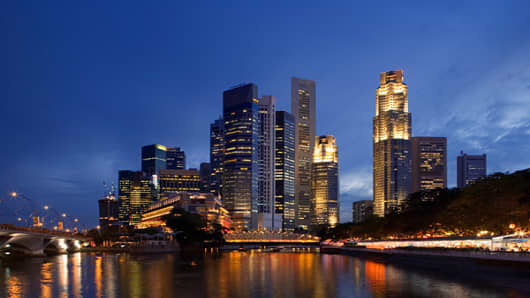Singapore is likely to announce more steps to slow an influx of foreign workers in a budget on Monday aimed at placating public anger about a surge in immigration blamed for overcrowding, rising prices and competition for jobs and housing.
The budget for the financial year starting in April is also expected to offer tax relief and grants to help companies cope with the changes in labor policy, as the government tries to raise wages of low-income Singaporeans without pushing the slowing economy into recession.
(Read More: Singapore's High Cost of Living Comes at a Cost)
Singapore, the Asian base for many Western multinationals and banks, enjoys large current account surpluses and the government holds huge reserves, giving ample room to raise spending on social services and help local companies.
Parliament recently approved a white paper that envisions the population of the small island nation growing by as much as 30 percent to 6.9 million by 2030. Foreigners will make up much of the rise, even if the pace of immigration is slowed.
The white paper sparked a rare public protest in the regimented state, just weeks after the long-ruling People's Action Party (PAP) lost a seat in parliament in a by-election.
"Addressing the electorate's concerns over social safety nets and inadequate infrastructure could receive further focus, especially in the wake of the PAP's surprise defeat," Citigroup economist Kit Wei Zheng said of the upcoming budget.
Singapore, ranked as the world's sixth-most expensive city by the Economist Intelligence Unit, is trying to restructure its economy by getting factories and restaurants to boost productivity to curb a reliance on low-skilled foreign workers.
(Read More: Youth Turning Their Backs on 'Singapore Dream')
Its efforts have raised the ire of employers, with the American and other chambers of commerce complaining of labor shortages and the Restaurant Association of Singapore saying eateries may be forced to shut down or move abroad.
DBS economist Irvin Seah said there could be measures in the budget to make it harder for firms to bring in mid-skilled workers to boost job opportunities for the rapidly rising number of Singaporeans with tertiary education - a view shared by Nina Alag Suri, the chief executive of recruitment firm Nastrac.
"There is a definite initiative to make sure that the numbers of (employment) passes are reduced so that the local population can be given a fair chance," she said.
Big Surpluses, Heavy Spending
For the fiscal year ending in March, the government is expected to report an overall budget surplus of as much as S$5 billion, helped by higher property taxes and stamp duties in a buoyant real estate market and a sharp rise in the auction prices of permits that motorists must have to buy new cars.
(Read More: Seventh Time Lucky for Singapore Property Measures?)
The surplus does not include income from government land sales, which is booked directly into state reserves. Inclusion of this figure would boost revenues by billions of dollars.
The surplus for fiscal 2012/13, including government land sales and all interest and dividend income, could be as large as S$24.9 billion or 8 percent of gross domestic product, said Citigroup's Kit. The Singapore government has a habit of underestimating its fiscal position and had predicted a surplus of S$1.27 billion for the year ending in March.
Other highlights in the budget, to be presented on Monday at about 3:30 p.m. (0730 GMT) by Finance Minister Tharman Shanmugaratnam, are likely to include:
- An increase in cash grants to lower-income Singaporeans to help them cope with inflation.
- Higher spending on healthcare in an ageing society.
- More incentives for couples to have children to try to raise Singapore's total fertility rate of 1.2 births per woman, one of the lowest in the world.
- Higher spending on infrastructure to ease congestion from the surge in immigrants over the past decade and cater for the envisioned rise in the population from the current 5.3 million.
Plans already made public include the doubling of Singapore's subway network to 360 km and land reclamation to facilitate the construction of 700,000 homes, both by 2030.
(Read More: Singapore: A Wealthy Nation That Can't Afford to Retire)
Jobs are plentiful in Singapore and the unemployment rate is below 2 percent but salaries tend to be low relative to the cost of living, especially for menial workers such as cleaners who make around S$1,000 a month due to competition from foreigners.
In his last budget, Tharman cut the proportion of low-wage foreign workers that firms can employ.
Companies in Singapore also pay levies for each foreign worker they employ. The levies, which are set to rise in July, do not apply to employment pass holders who are mostly professionals and executives.


